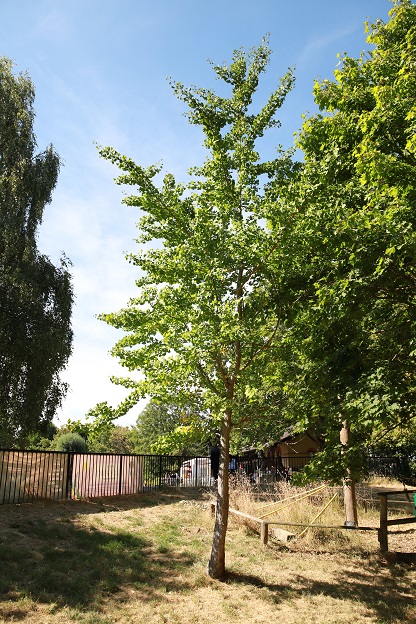Stephen Middleton from the Friends of Alexandra Park is kindly introducing us to his favourite trees in the Park. Here’s his pick this month…
Back in the mists of time our August Tree of the Month was already thriving. It is certainly the tree with the oldest heritage in the park. Fossil records of similar trees date back to before the age of the dinosaurs and this species may have been relatively unchanged for the last 200 million years. The Ginkgo or Maidenhair Tree (Ginkgo biloba) is located near to the Boating Lake not far from the statue of the lion, but just outside the railings near the end of a Go-Ape zip wire.
Ginkgos form one division of a large group of plants called gymnosperms meaning naked seeds (the seeds are not contained in an ovary like broadleaved trees). There is just the one species still surviving. Other divisions within this grouping include the conifers and the cycads.
Its leaves have a very distinctive fan shape with a little notch half way round. In autumn, these leaves will often turn a striking yellow or orangey yellow colour. The bark is also worth a look with its corky, roughly ridged appearance.
Each Maidenhair tree is either male or female. Males are usually planted as the females produce quite a lot of unpleasant smelling fruit. One downside to the male trees is that pollen can cause problems for hay fever sufferers.
Check out your local area as they have recently become a popular tree for planting in streets suffering very little from pests and diseases. Its upright stance is suitable for a lot of locations.

In folklore the tree has been thought to be a symbol of unity (of the Chinese nation), peace, longevity, enlightenment and hope.
The wood from the ginkgo is light and low strength so not very useful. Various parts of the tree have been eaten, but do contain toxins. Similarly the leaves are used in traditional Chinese medicine for various ailments although no conclusive proof has yet been found for its effectiveness.
Ginkgos had in the past a widespread distribution, but are now found growing as native trees in only a small part of China notably on the slopes of the Tianmu mountain in Zhejiang province. They are more commonly found in the grounds of religious buildings in China and Japan.
The tree’s resilience was famously demonstrated when some survived at distance of only about a mile from the Hiroshima bomb.
The Maidenhair tree (the name coming from its leaves’ similarity to the Maidenhair fern) can live for over a thousand years and reach up to 40 to 50 metres, when conditions are perfect.
There is just one other Ginkgo to spot in the park. It is located, perhaps appropriately, just outside the “Little Dinosaurs” play area on the eastern side.






